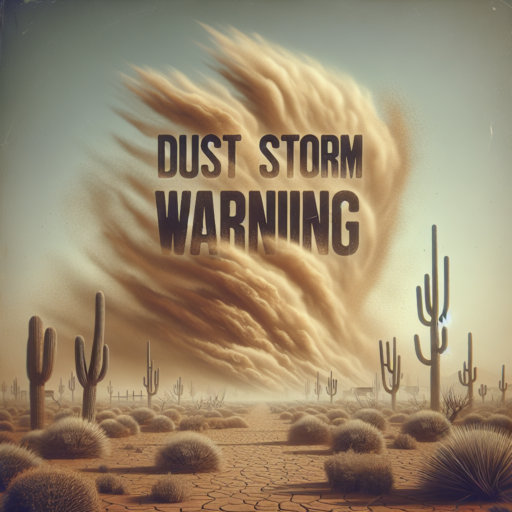Understanding Dust Storm Warnings
Dust storms are a force of nature that can have significant impacts on visibility, health, and safety. Grasping the essence of dust storm warnings is crucial for preparing and protecting oneself from the potential dangers they present. These warnings are issued by meteorological agencies when there is a high likelihood of a dust storm occurring in an area, indicating that precautions should be taken by residents and travelers alike.
There are several key components to understanding dust storm warnings. Firstly, it’s essential to know the terminology used, such as «dust advisory,» «dust watch,» and «dust warning.» Each term signifies a different level of threat, with advisories being the least severe and warnings suggesting immediate action is necessary to safeguard life and property. Secondly, the timing and duration of the warning are critical. This information helps individuals and communities to plan and execute necessary safety measures before the storm hits.
Another aspect to consider is the geographical coverage of the warning. Dust storms can cover extensive areas and affect multiple regions differently. Knowing the specific areas under threat can help in understanding the potential scale and impact of the impending storm. Additionally, paying attention to the advice and safety tips provided by authorities during these warnings can significantly mitigate the risks associated with dust storms.
How to Prepare for a Dust Storm Warning
When a dust storm warning is issued, your immediate actions can significantly impact your safety and health. These storms, filled with fine particles, can reduce visibility drastically and pose serious health risks. Preparing in advance is crucial, and there are several steps you can take to ensure you’re ready when the air fills with dust.
Stay Informed About the Dust Storm
One of the first steps in preparing for a dust storm warning is staying informed. Monitoring local weather forecasts and alerts can give you a head start on preparations. Many regions prone to dust storms have specific warning systems in place. Subscribing to weather alerts on your phone or using a NOAA Weather Radio can provide you with immediate updates, giving you the crucial time needed to react appropriately.
Secure Your Home
Securing your home is a key aspect of preparing for a dust storm. Begin by closing all windows, doors, and air vents to prevent dust from entering. If you have any outdoor furniture, tools, or toys, bring them inside or secure them properly to prevent damage. Applying weather strippingaround doors and windows can also help keep dust out. Additionally, consider adjusting your home’s air conditioning system to recirculate indoor air, minimizing the influx of dusty air from outside.
Prepare an Emergency Kit
An emergency kit is essential for any natural disaster, including dust storms. Your kit should include a variety of items: water, non-perishable food, a first-aid kit, flashlights, extra batteries, and dust masks or respirators to protect your lungs from the fine particles in the air. Ensuring you have enough supplies to last at least 72 hours is recommended. Remember to check your kit regularly and replace any expired items to keep it up-to-date.
Dust Storm Warning Signs and Symptoms
Understanding dust storm warning signs and symptoms is crucial for your safety and health. These meteorological phenomena can arise suddenly, but there are often indicators that can alert you to their impending arrival. Recognizing these signs can help you take necessary precautions to protect yourself and your loved ones.
Early Warning Signs
Before a dust storm occurs, you may notice changes in the atmosphere and environment. Such changes include a noticeable increase in wind speed, a sudden drop in temperature, and a significant change in the sky’s color, often turning a deep red or orange hue. These signs can indicate that a dust storm is forming nearby, providing you with the opportunity to seek shelter before conditions deteriorate.
Health Symptoms
Exposure to a dust storm can lead to various health symptoms. Individuals might experience respiratory difficulties, such as coughing, shortness of breath, and an increase in asthma symptoms. Additionally, dust particles can irritate the eyes, resulting in redness, itching, and, in more severe cases, temporary vision impairment. It’s essential to cover your nose and mouth with a mask or cloth and wear protective eyewear if you find yourself caught in a dust storm.
What to Do During a Dust Storm Warning
When a dust storm warning is issued, it’s crucial to take immediate action to ensure your safety and minimize the impact of the storm. Dust storms, also known as sandstorms, can drastically reduce visibility and air quality, pose serious health and safety risks, and disrupt transportation. Below are essential steps you should take upon receiving a dust storm warning.
Seek Shelter Immediately
One of the most important actions to take during a dust storm warning is to find shelter. If you are indoors, stay there. Close all windows, doors, and any other openings to prevent dust from entering. For those caught outside, seek shelter in a nearby building or vehicle. If finding shelter is not an option, use a piece of cloth to cover your nose and mouth to protect yourself from inhaling dust particles.
Limit Outdoor Activities
Limits on outdoor activities are highly recommended during a dust storm warning. Exposure to dust can lead to respiratory problems and other health issues. It’s best to postpone outdoor activities until the storm has passed and the air quality has improved. If you must go outside, wearing protective eyewear and a face mask can help reduce the health risks posed by the dust storm.
Stay Informed
Staying informed is key during a dust storm warning. Monitor local news and weather channels, as well as online updates from the National Weather Service or local government agencies, for the latest information on the storm’s progress and advice. Knowing the expected duration and severity of the dust storm can help you make more informed decisions about how to protect yourself and your loved ones.
No se han encontrado productos.
Aftermath of a Dust Storm: Safety Tips and Precautions
The aftermath of a dust storm can leave a community grappling with not only the immediate cleanup but also concerns for public health and safety. Once the storm has passed, the fine particles left behind can still pose significant health risks, particularly to those with respiratory conditions. Understanding the necessary safety tips and precautions is essential for navigating this challenging period effectively.
Assessing Outdoor Environment
After a dust storm, one of the first steps you should take is assessing the outdoor environment for potential hazards. This involves checking for fallen debris that can block pathways or damage property. It’s also crucial to consider the air quality before you spend significant time outside. Particles from the storm can linger in the air for days, exacerbating conditions such as asthma and allergies. Wearing protective masks and avoiding outdoor activities until air quality improves are prudent measures.
Cleaning and Sanitizing
Cleaning up after a dust storm involves more than simply sweeping and dusting. It is important to thoroughly clean all indoor surfaces to remove the fine dust particles that have infiltrated during the storm. Wet wiping rather than dry dusting can prevent these particles from becoming airborne again. Additionally, consider the use of air purifiers to filter out any remaining dust within your home. Remember, sanitizing frequently touched surfaces is also critical to prevent the spread of any possible contaminants that were carried by the storm.
The Science Behind Dust Storm Warnings
Understanding the science behind dust storm warnings is pivotal for ensuring public safety and minimizing the adverse impacts on health and infrastructure. These warnings are based on a complex interplay of meteorological data and predictive modeling. At the core of these forecasts are detailed analyses of atmospheric conditions, including temperature, humidity, wind patterns, and the topographical features of specific areas that can give rise to dust storms.
Atmospheric Monitoring and Predictive Models
Experts utilize advanced atmospheric monitoring technologies to track the conditions that lead to the formation of dust storms. Stations equipped with sensors across vulnerable regions measure wind speed and direction, atmospheric pressure, and humidity levels continuously. This real-time data, combined with satellite imagery and radar systems, feeds into predictive models. These sophisticated models can forecast the likelihood of dust storms, allowing for timely warnings to be issued to the public and authorities.
Importance of Early Warning Systems
Early warning systems play a crucial role in mitigating the dangers posed by dust storms. By providing prior notice, these systems enable people to take necessary precautions, such as sealing homes, wearing protective gear, or altering travel plans. Moreover, they allow authorities to implement preemptive measures to safeguard critical infrastructure and reduce the potential for traffic accidents and health issues, emphasizing the critical importance of accurate and timely dust storm predictions.
Overall, the science behind dust storm warnings is an intricate blend of meteorological study, technological advancement, and strategic preparedness. Through continuous research and development, the accuracy of these warnings is ever-improving, aiming to preserve the safety and well-being of communities in dust-prone regions.
Top 5 Safety Measures to Take During a Dust Storm Warning
When a dust storm warning is issued, it’s imperative to prioritize safety and prepare accordingly. Dust storms can impair visibility, exacerbate respiratory issues, and create hazardous driving conditions. Here are the top five safety measures you should consider to protect yourself and your loved ones during such events.
Seek Indoor Shelter Immediately
One of the most effective ways to shield yourself from the dangers of a dust storm is to seek shelter indoors. Ensure all windows and doors are securely closed to prevent dust from entering. Staying indoors minimizes exposure to fine particles that can lead to respiratory problems.
Protect Your Respiratory System
For those who must venture outside, wearing a mask or a damp cloth over your nose and mouth can help filter out dust particles. This is particularly crucial for individuals with pre-existing respiratory conditions, such as asthma or COPD, who are more vulnerable to the effects of dust storms.
Reduce Travel
Avoid driving during a dust storm if possible, as visibility can drop significantly, increasing the risk of accidents. If you’re caught driving when a dust storm hits, pull over to the side of the road, turn off your vehicle’s lights, set the emergency brake, and wait until the storm passes. It’s essential to turn off your lights to avoid being mistaken for a moving vehicle.
Understanding these safety measures can significantly reduce the risks associated with dust storms. By staying informed and prepared, you can protect yourself and your community from their potentially harmful effects.
How to Stay Informed About Dust Storm Warnings
Staying ahead of dust storm warnings is crucial for ensuring your safety and minimizing the impact of these potentially dangerous events. With the rise in frequency and intensity of dust storms in certain regions, being informed has never been more important. There are several reliable methods to keep yourself updated and prepared for when the winds start kicking up the dust.
Subscribe to Weather Alert Systems
One of the most effective ways to stay informed about dust storm warnings is by subscribing to weather alert systems. Many national and local weather services offer free alerts that can be sent directly to your mobile device or email. These alerts are typically issued well in advance, giving you ample time to prepare. Ensure that your subscriptions are active and check that notifications are not being sent to your spam folder.
Follow Trusted Meteorological Websites and Apps
In today’s digital age, numerous websites and apps are dedicated to providing up-to-the-minute weather forecasts and warnings. Find a few reputed meteorological websites (such as the National Weather Service or AccuWeather) and apps that offer detailed information on dust storms and their expected paths. Regularly checking these sources can provide you with a comprehensive understanding of the conditions that may lead to dust storms in your area.
Utilize Social Media and Community Resources
Lastly, social media platforms and community forums can be valuable resources for real-time information on dust storms. Following local government and emergency services accounts on platforms like Twitter and Facebook can offer immediate updates during active dust storm events. Additionally, community forums and groups are often among the first to share observations and safety tips, creating a support network of informed citizens.
Impact of Dust Storms on Health and Environment
Dust storms, a common environmental phenomenon, carry with them not just sand and dust but also a myriad of potentially significant impacts on health and the environment. Understanding these impacts is crucial for global health and environmental preservation.
Health Implications of Dust Storms
Dust storms can have a profound effect on human health, with respiratory issues being among the most evident consequences. Particles of sand and dust can easily be inhaled, leading to a range of respiratory problems, from simple irritation of the nose and throat to more serious conditions such as asthma exacerbation, bronchitis, and even acute respiratory infections. The very young, the elderly, and individuals with pre-existing respiratory or cardiovascular conditions are particularly vulnerable. Additionally, dust storms can carry pathogens and allergens that exacerbate allergies and can lead to the spread of diseases.
Environmental Consequences of Dust Storms
The environmental effects of dust storms are equally significant. These storms can lead to degradation of soil quality by removing the top layer of fertile soil, which impacts agricultural productivity and ecosystem health. Furthermore, the deposition of dust can alter the nutrient balance in both terrestrial and marine ecosystems, potentially leading to changes in species composition and functioning. Dust can also affect the air quality considerably, reducing visibility and contributing to pollution, which has broader implications for climate change.
Moreover, the impact on water sources is another critical consideration. Dust particles can contaminate water supplies with pollutants and microorganisms, posing risks to both human health and wildlife. The intricate relationship between dust storms, health, and environmental integrity highlights the complexity of these natural events and the importance of comprehensive monitoring and management strategies to mitigate their effects.
Dust Storm Warning vs. Watch: Understanding the Difference
Understanding the difference between a dust storm warning and a dust storm watch is crucial for ensuring your safety and preparedness during severe weather conditions. Both terminologies alert residents about potential or imminent dust storms, but they signal different levels of urgency and action required.
A dust storm warning is issued by weather authorities when a dust storm is already happening or imminent within a very short time frame, typically within an hour. This means that visibility will be significantly reduced and conditions will be dangerous. If you find yourself under a dust storm warning, it is advisable to seek shelter immediately and avoid travel unless absolutely necessary. On the other hand, a dust storm watch is announced when conditions are favorable for a dust storm to occur but has not yet developed. This watch serves as a preparatory alert, giving individuals and communities time to prepare for potential adverse conditions.
Actions to Take During Each Alert
- During a Dust Storm Watch: Stay informed by monitoring local weather updates, secure outdoor objects that could blow away or cause damage, and prepare for the possibility of staying indoors for an extended period.
- During a Dust Storm Warning: If outdoors, find shelter immediately. If driving, pull over, turn off your vehicle’s lights, set the emergency brake, and wait until visibility improves before proceeding.
The distinction between these alerts allows individuals to make informed decisions to protect themselves, their families, and their property. By staying alert and understanding these differences, you can ensure your safety during these potentially hazardous conditions.




